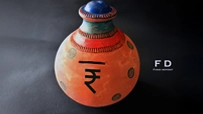Kisan Vikas Patra vs National Savings Certificate vs Bank FD: Choosing the Right Option
Disclaimer: This blog is generic in nature. Ujjivan does not offer NSC or Kisan Vikas Patra. Please consult an investment adviser to make an informed decision.
October 23, 2025

For generations, Indians have valued saving as much as earning. From Kisan Vikas Patra to the National Savings Certificate, every household had its own trusted way to grow money safely. These schemes earned faith at a time when security mattered more than speed.
Today’s investors want their money to be just as safe, yet easily accessible whenever life calls for it. That’s where Fixed Deposits (FDs) step in. They blend the trust and stability of traditional saving with modern convenience, from instant online account opening to hassle-free withdrawals — all while ensuring steady, guaranteed returns.
This article explains how each option works, how they differ, and which one might suit your savings goal best.
What Is Kisan Vikas Patra (KVP)?
Kisan Vikas Patra (KVP) was designed for a different time, when savings were meant to be untouched for years.
When you invest in KVP, you get a certificate that shows how much you invested and when it will double. At the current rate of about 7.5% per year, your money doubles in roughly 115 months (that’s about 9 years and 7 months).
But that same long horizon can be its limitation today. For someone saving with shorter financial goals in mind — say, a child’s education, or buying a car — waiting nearly a decade can feel restrictive.
That’s why many modern savers prefer FDs. FDs today offer comparable returns with flexible tenures and early-withdrawal options, making them more suited to today’s lifestyle.
What Makes the National Savings Certificate (NSC) Popular?
National Savings Certificate (NSC) is a Government-backed investment instrument that’s been around for decades. You can buy it from any post office. The scheme currently offers around 7.7% interest (this rate changes slightly, depending on government reviews).
NSCs come with a lock-in period of 5 years. While it provides a tax deduction under Section 80C, consider the lock-in period before depositing your money.
FDs, on the other hand, let you plan on your own terms — choose tenure, break early with minimal penalty (allowed only for callable FDs, early withdrawals may cause loss of earnings), and still enjoy steady, predictable growth.
How Do Bank Fixed Deposits (FDs) Compare?
Fixed Deposits offer safe and assured returns. You deposit a lump sum for a particular tenure, which could be as short as 7 days or as long as 10 years, and you earn a fixed interest rate for that period.
Today’s FDs have evolved far beyond paper slips and branch visits. You can open an FD online in minutes, renew automatically, and earn high interest rates— even higher for senior citizens.
Bank FDs suit people who want flexibility, steady returns, and the option to withdraw early if they ever need the money. Whether you want short-term liquidity or long-term stability, an FD adjusts to your goals without compromise.
FDs Vs Other Traditional Savings Options
Let’s look at how KVP, NSC, and Bank FDs differ in key areas like interest rate, tenure, and flexibility.
| Feature | KVP | NSC | Bank FD |
| Interest Rate | 7.5% | 7.7% | Ujjivan offers higher interest rates |
| Tenure | 9 years 7 months | 5 years | 7 days – 10 years |
| Minimum Investment | ₹1,000 | ₹1,000 | ₹1,000 (varies by bank) |
| 80C Tax Benefit | No | Yes | Yes (only 5-year FD) |
| Premature Withdrawal | After 2.5 years (limited) | Not allowed | Allowed for callable FDs (subject to terms and conditions) |
| Liquidity | Low | Low | High |
| Safety | Govt-backed | Govt-backed | Insured up to ₹5 lakh per bank |
Final Thoughts
Kisan Vikas Patra and National Savings Certificate have long been symbols of secure saving. They were built for a time when people could wait patiently for their money to grow. But today, life moves faster — goals arrive sooner, and access matters as much as safety.
That’s why Fixed Deposits continue to stay relevant. They carry the same trust and discipline of traditional saving, but with modern ease. Today's FDs offer digital access, flexible tenures, and assured returns. You can plan short-term goals or long-term ones without locking your funds away for years.
Disclaimer:
The contents herein are only for informational purposes and generic in nature. The content does not amount to an offer, invitation or solicitation of any kind to buy or sell, and are not intended to create any legal rights or obligations. This information is subject to updation, completion, amendment and verification without notice. The contents herein are also subject to other product-specific terms and conditions, as well as any applicable third-party terms and conditions, for which Ujjivan Small Finance Bank assumes no responsibility or liability.
Nothing contained herein is intended to constitute financial, investment, legal, tax, or any other professional advice or opinion. Please obtain professional advice before making investment or any other decisions. Any investment decisions that may be made by the you shall be at your own sole discretion, independent analysis and evaluation of the risks involved. The use of any information set out in this document is entirely at the user’s own risk. Ujjivan Small Finance Bank Limited makes no representation or warranty, express or implied, as to the accuracy and completeness for any information herein. The Bank disclaims any and all liability for any loss or damage (direct, indirect, consequential, or otherwise) incurred by you due to use of or due to investment, product application decisions made by you on the basis of the contents herein. While the information is prepared in good faith from sources deemed reliable (including public sources), the Bank disclaims any liability with respect to accuracy of information or any error or omission or any loss or damage incurred by anyone in reliance on the contents herein, in any manner whatsoever.
To know more about Ujjivan Small Finance Bank Products Visit:"https://www.ujjivansfb.in"
All intellectual property rights, including copyrights, trademarks, and other proprietary rights, pertaining to the content and materials displayed herein, belong
to Ujjivan Small Finance Bank Limited or its licensors. Unauthorised use or misuse of any intellectual property, or other content displayed herein is strictly prohibited and the same is not intended for distribution to, or use by, any person in any jurisdiction where such distribution or use would (by reason of that person’s nationality, residence or otherwise) be contrary to law or registration or would subject Ujjivan Small Finance Bank Limited or its affiliates to any licensing or registration requirements.
FAQs
1. What is the current interest rate for Kisan Vikas Patra (KVP)?
It’s around 7.5% per year, and your money doubles in about 115 months (9 years and 7 months).
2. How much can I invest in KVP or NSC?
The minimum is ₹1,000, and there’s no upper limit for KVP. For NSC, you can invest as much as you want, but only up to ₹1.5 lakh qualifies for the 80C tax deduction.
3. Can I withdraw my KVP before maturity?
Yes, but only after 2 years and 6 months, and only under certain conditions like the investor’s death or court orders.
4. Is the interest on NSC taxable?
Yes, it is. However, the interest that gets reinvested each year is treated as a fresh investment and qualifies for 80C deduction during the early years.
5. Do bank FDs offer better returns than KVP or NSC?
Sometimes yes, sometimes no. FD rates depend on the bank and tenure — they usually range between 6% and 8%. Private banks often offer higher rates than government ones.
6. How are these different from mutual funds or market investments?
KVP, NSC, and FDs give fixed returns and carry no market risk, while mutual funds depend on market performance. They’re best for those who prefer stability over high but uncertain returns.
Latest Blogs

What is the Latest GST Rate on Purchase of Property in India?
Buying a home is a dream for many, but it comes with its share of taxes and paperwork.

Occupancy Certificate in Bangalore: Importance, Process & New Rules
Occupancy Certificate (OC) is a critical document certifying that a new building is safe and legal to occupy.

New Credit Loss Norms: Why RBI’s Long Transition Period Is Good News for Banks
The Reserve Bank of India (RBI), with the introduction of new Expected Credit Loss (ECL) norms, is aiming further to modernize the country’s banking framework.

10 Common Bank Transactions That Can Draw the Income Tax Department’s Attention
Many taxpayers assume that simply filing their returns on time keeps them off the radar of the Income Tax Department. The reality, however, is more complex.

Choosing Between Regular Pension Plans, NPS Lite & Atal Pension Yojana After New PFRDA Update
For decades, a pension meant a fixed monthly income, guaranteed by the government or employer





